
Tensioning
1. The screw driven internal tone ring
(*Note: this model was the first ever ever of it's type, made in 1975 by Seamus O'Kane and is not available, and was so important that it changed forever bodhrán making and influenced bodhrán playing possibilities. In the photographs below, please notice the masking tape, which shows some early attempts at tone moderation.)
In 1975 while on Holidays in Gaoth Dobhair in Donegal, I went nightly to sessions in Hiúdaí's bar. The high humidity always slackened the skin and made it unplayable. When I got home I sought to remedy this.
3 months later at a session in Ballinascreen I met up with an old friend, Joe Diamond who was playing a banjo that he had built. While I was examining it I got the idea for solving my problem;- a moveable internal tone ring. It was the exact opposite to the tuning system on the banjo, where the mechanism pulled from the outside. Mine would push from the inside. A week later I was playing it.
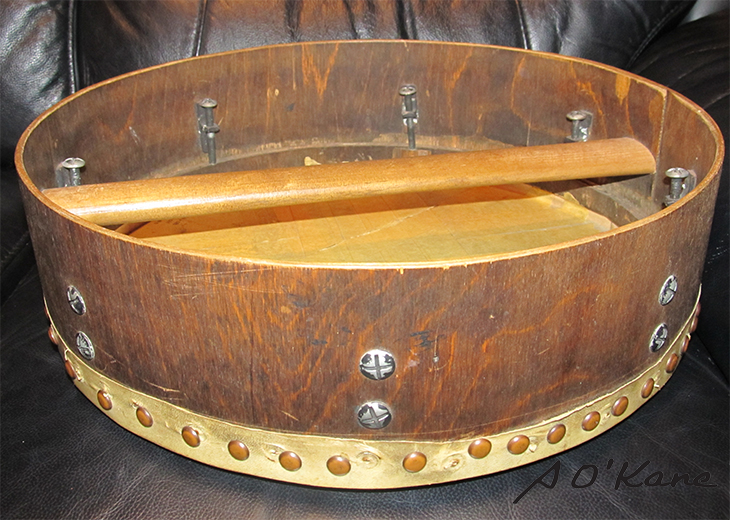
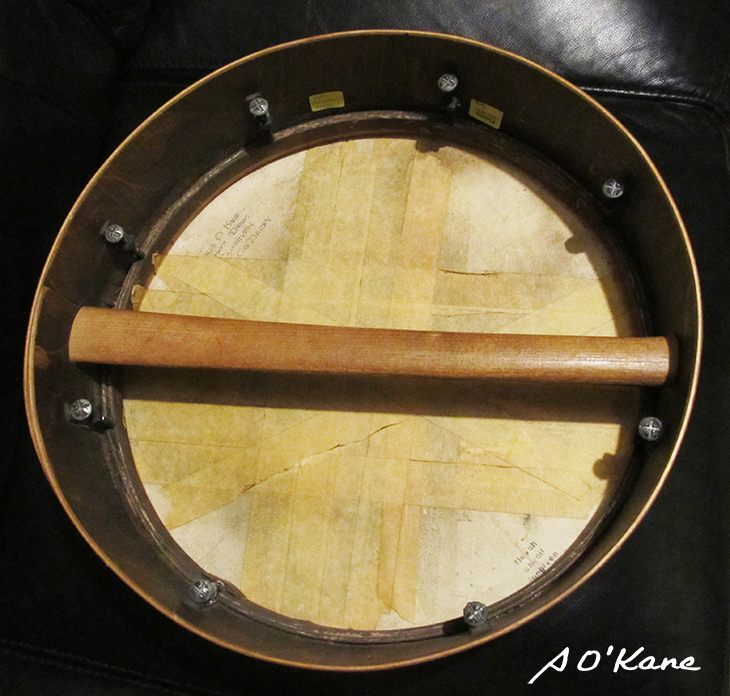
This idea was to destined to change forever bodhrán and hand drum making worldwide. That was late 1975.
For the next few years nobody noticed this inventive step, except for a few local bodhrán players, mainly Gino Lupari, and some others who saw it either in Donegal or at fleadhs. It never ever occurred to me that it was such an important idea. To me it was a private solution to a private problem.
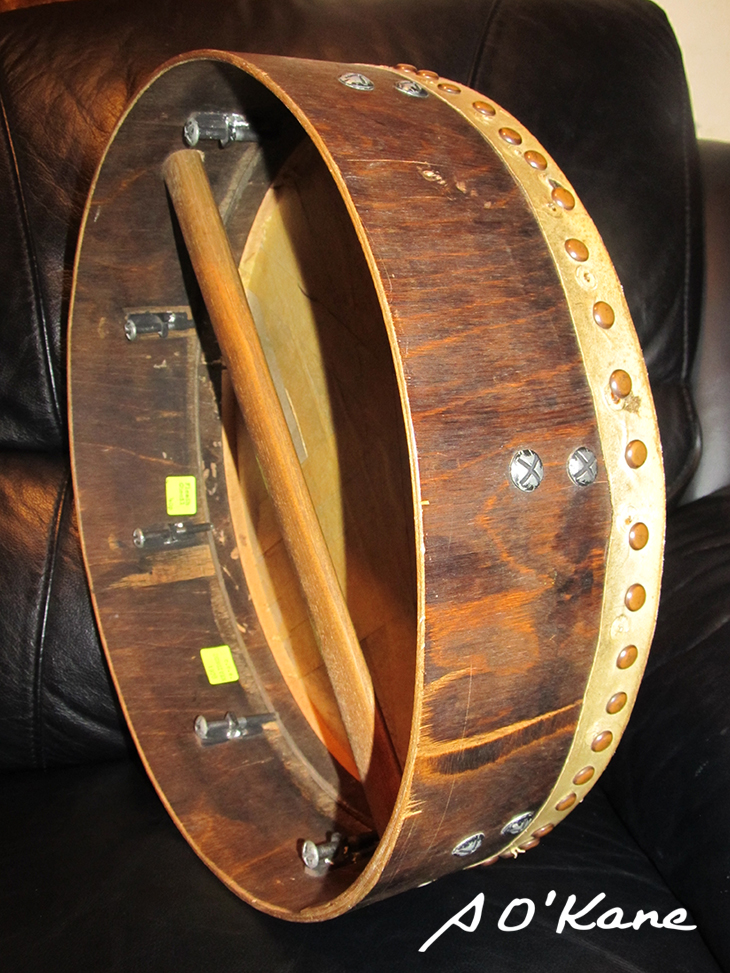
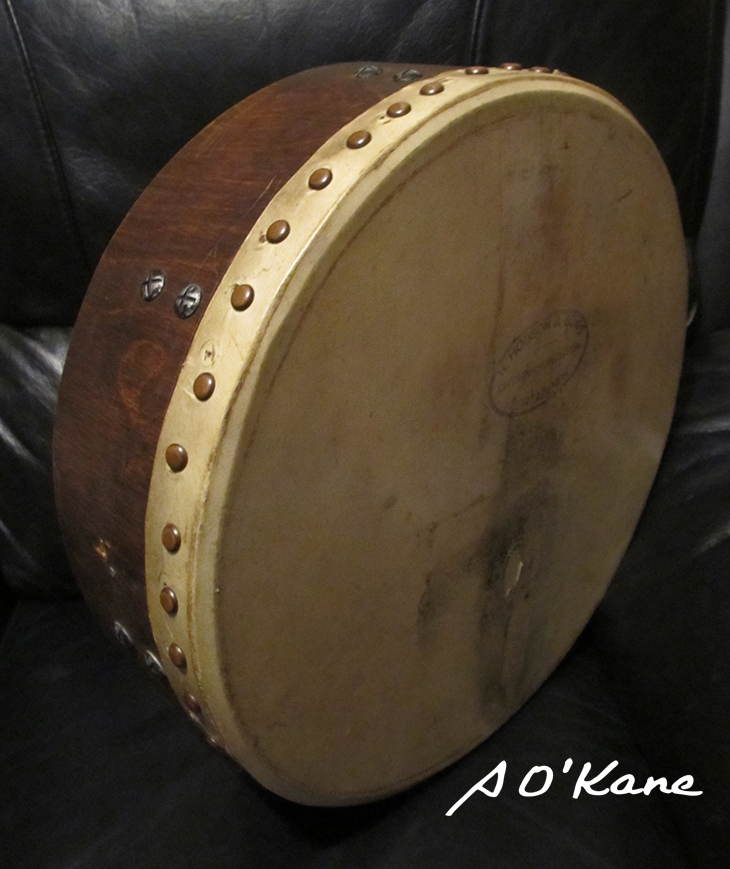
At this stage, rough though it was, I had answered the problem of tensioning the skin About 1981-3 other makers began to notice and refine the idea and, had they not, then possibly the idea would have remained unnoticed. To see my idea being copied gave me a sense of great pride. Initially the idea that such an ethnic drum design should be tampered with caused annoyance amongst other big makers. Progress gladly prevailed.
Tensioning system
2. George McCann’s design - split shell type.
About 2 years after I made the first of my tensionable type, George Mc Cann from Cookstown in Co. Tyrone made a bodhrán for his wife Teresa. In my opinion his idea was the single biggest inventive step in bodhrán development and sadly unnoticed by other makers, since George was such a private person.
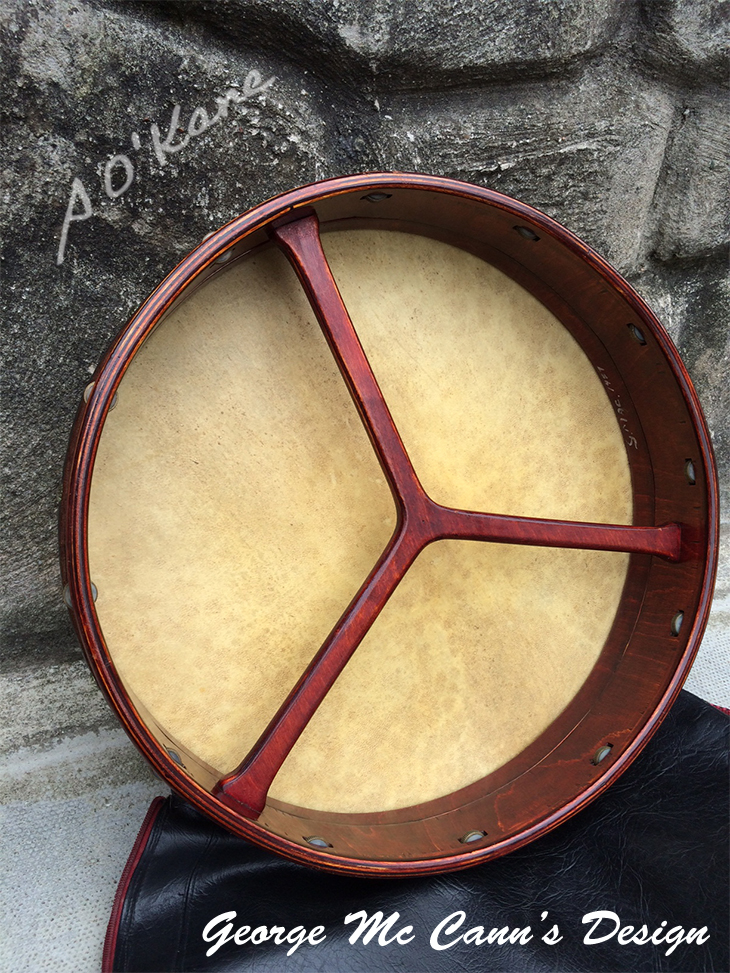
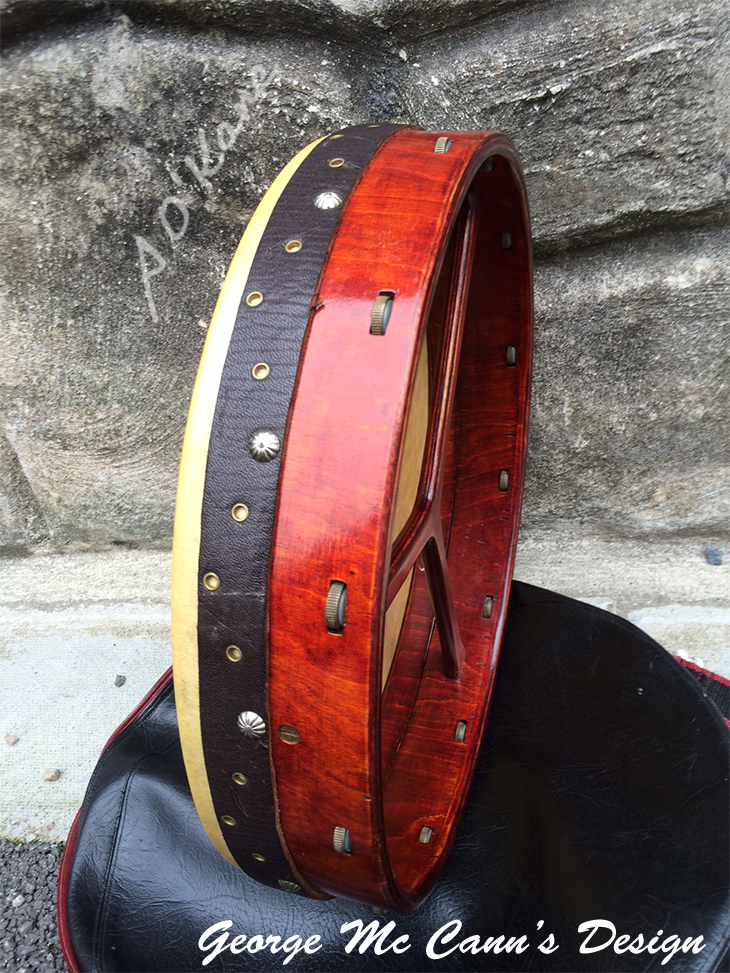
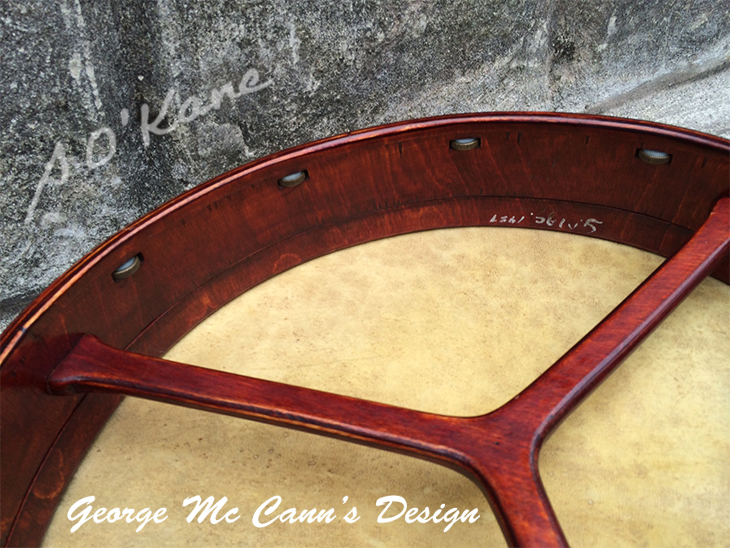
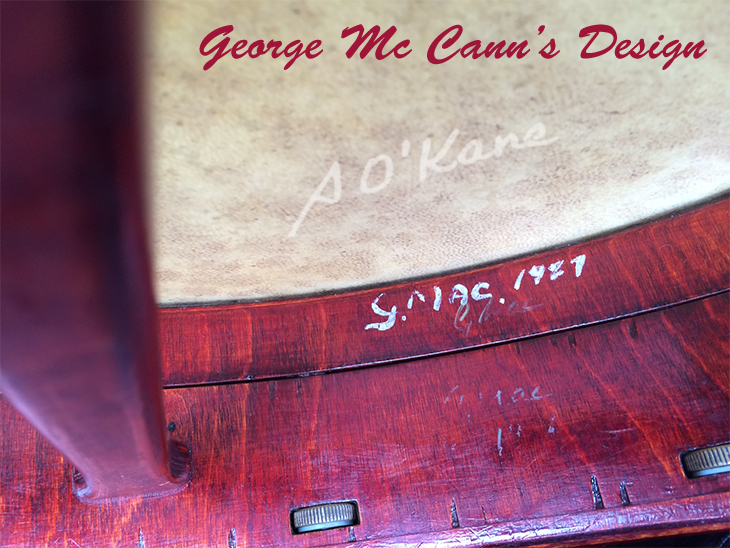
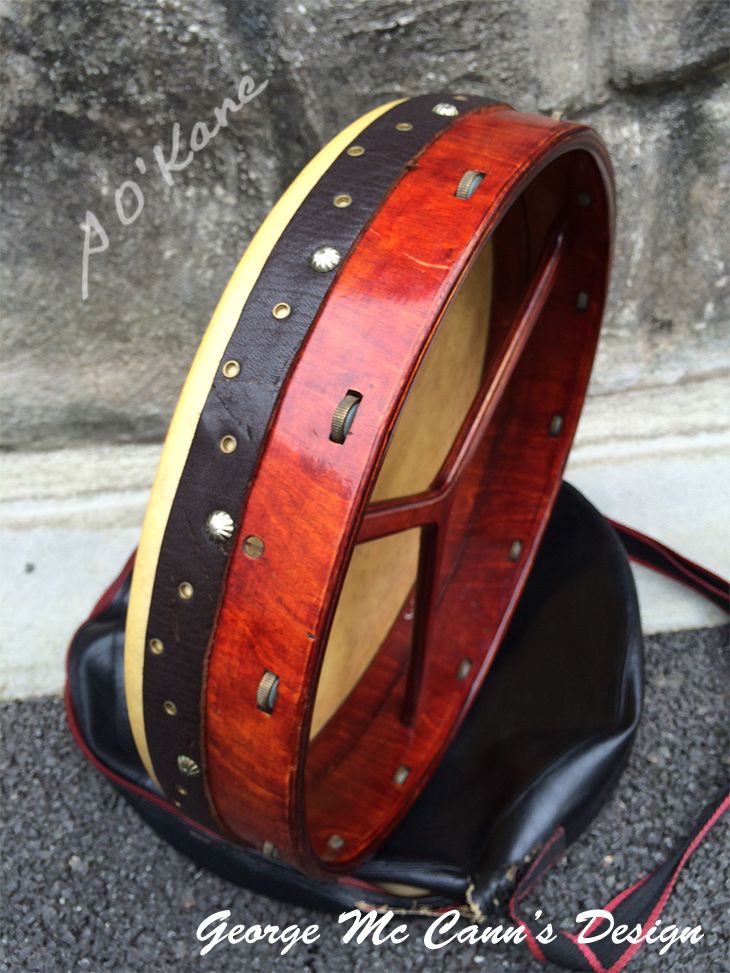
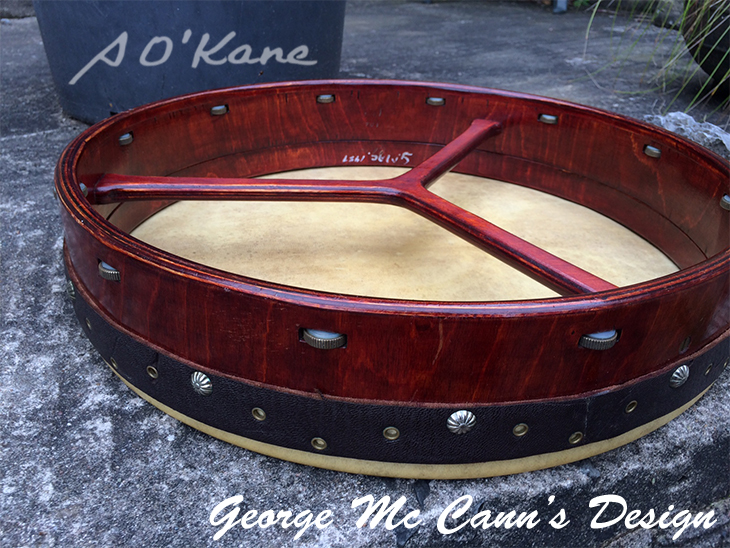
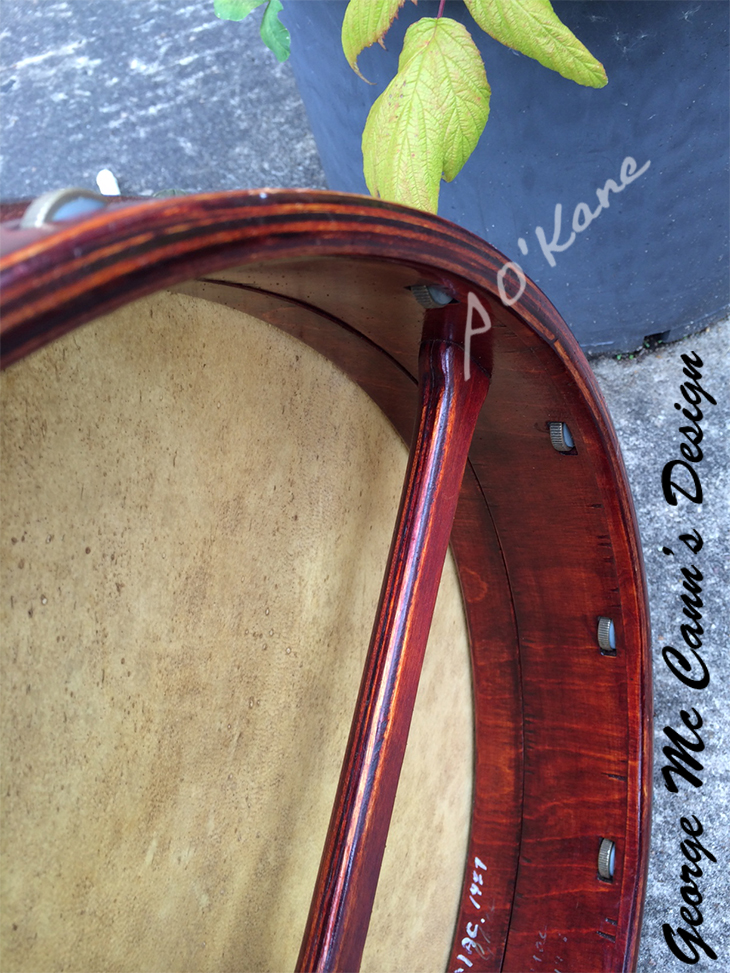
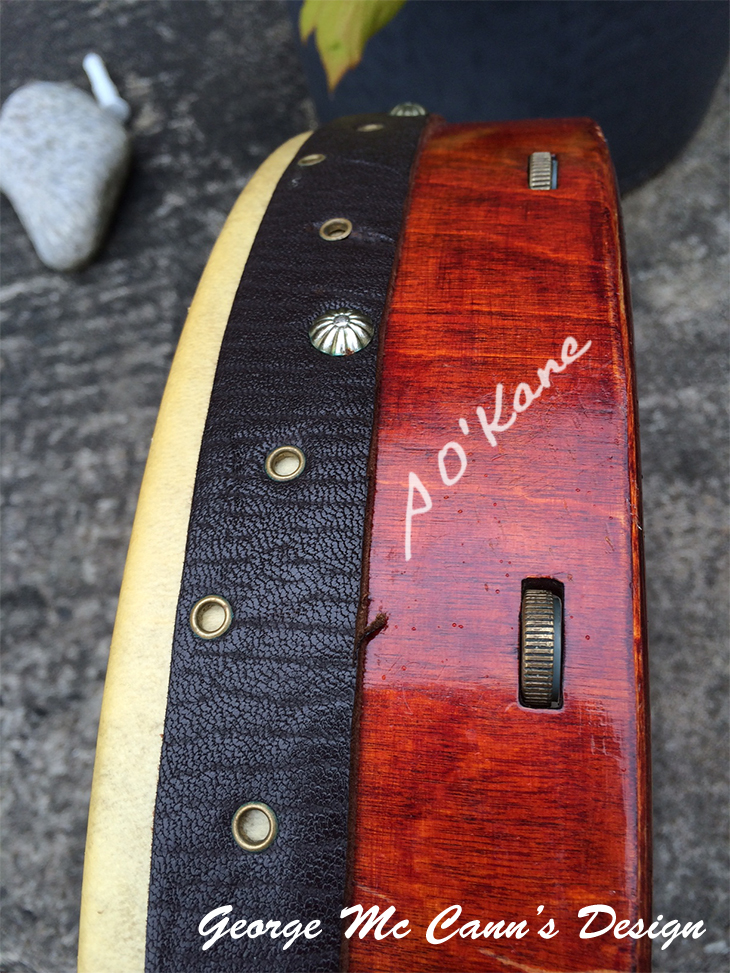
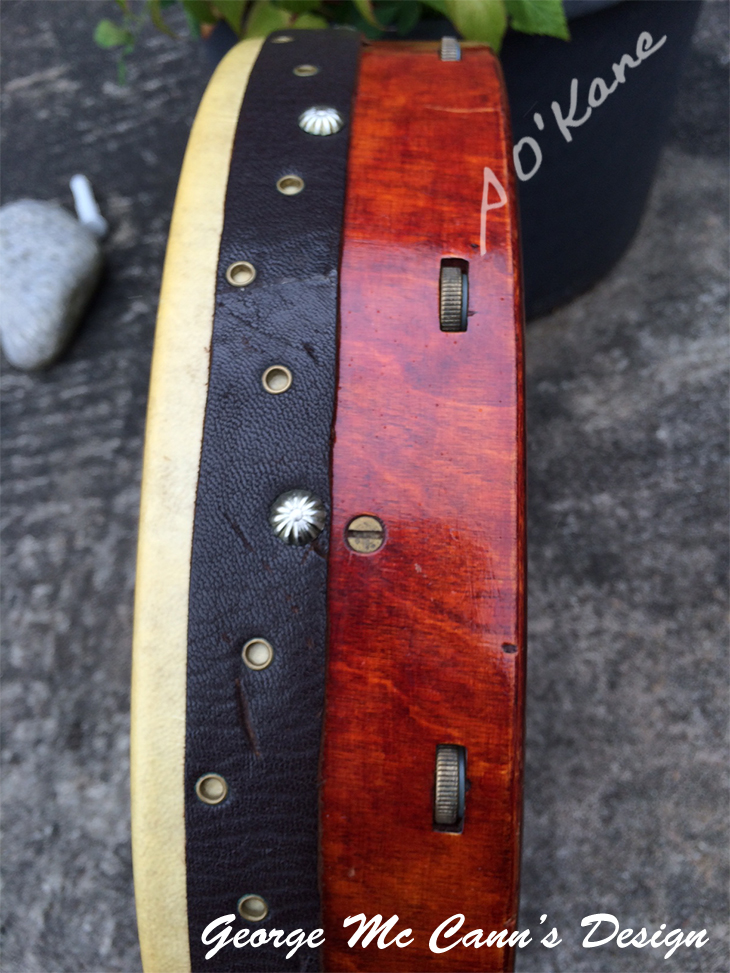
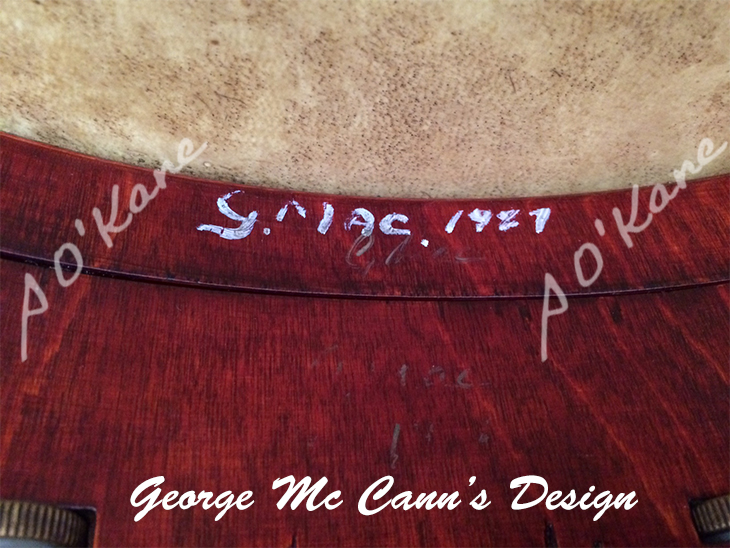
Over all these years I have watched with interest, other makers reinventing honestly his idea, but always falling short of what he did. Some got so close, but only within these past 4 years has the idea been recreated/reinvented to his standard.
I write this in recognition of George’s achievement and so that such a quiet, modest man gets credit for his work... without belittling those who now make the same idea.
MODERATING THE SOUND
The problem of skin tensioning was answered but the problem of moderating the sound was not. Drums still sounded unacceptable loud and rough. Most makers were well aware of this problem and many players had their own solutions. How or what moderates the sound?
For me there were 4 experimental paths:
The first method is temporary and can be easily altered, so I chose to use this. The other 2 methods are permanent.
After about 5 or 6 years of experimenting, I finally settled on the first method…. where I applied duct tape to the outer edge. Johnny Mac Donagh showed that he used electrical tape so I took his advice and have used it ever since. Since it has now become a trade mark of my drums, I keep using this method. It has become a much copied idea thereafter. Blindly copying the work of other people can sadly limit the design progress of sound production, and so the possibilities of method 2 remain, by and large, unexplored.
Eventually I learned how to moderate the sounds and so could make every drum a fairly good one. At this stage in the late 1970’s other makers, no matter how good, could never predict their results. Exceptional makers could achieve about a 30% success rate, the average makers about 5%, and good sounding drums were very rare... and highly prized.
Tensioning system
3. Cam Design
(*Note this model is no longer available, and has been superceded by the New Cam Type system [please see; "6. THE NEW CAM TYPE" system, below]).
A few years later when Dervish were forming, I made a drum especially for Cathy Jordan so that she would not have to search about for a screwdriver. As can be seen in the photo the screw and block is replaced by a plywood cam. The tuning range was relatively small and the wood against wood proceed a burnished shiny surface that tended to backslide. As a friend decided that he wanted to make this type I stepped aside after redesigning it and making a sample for him. He gave up making drums shortly afterwards.

At this stage in my life my family were growing up and to pay the bills I had to become much more professional in my approach and make more drums. Fortunately there was a change in bodhrán playing technique that suited my drums. Players like Junior Davey, Ronan Moloney, John Joe Kelly and many others that I have not met were developing new ideas and exploiting sounds that could be found in thinner skins, From these player’s classes emerged students kept on rolling out a new style.
Johnny McDonagh put me onto the idea of the electrical tape instead of the duct tape that I had been using. This was the black ring of tape around the outer circumference of the skin to moderate the sound. I have used that ever since, initially telling others that it was for decoration. Most makers of this drum type now use this idea. The more traditional makers don’t and use something else.
Using other ideas in shell construction and skin treatment, whilst still retaining the old traditional bodhran look , the sound quality and durability of the skin got slightly better... higher highs and lower lows, crisp and clean with no woolly sounds.
So the sound of my drums became the standard for drums of this type, but not the sound sought by some other makers who preferred to stick to the older traditional sounds that were more percussive if less musical. Thus the player now has to choose the style he will play and can buy a drum to suit his choice. There is no right or wrong. It is simply a matter of individual taste. Generally musical drums have the tape of whatever colour, the percussive type do not.
TENSIONING SYSTEM
4. Single Screw – Rack & Pinion type
(*Note: the Rack and Pinion type tensioning system is no longer available. It was superceded by the Single Point Tensioning system [see: "5. Single Screw – Band Tensioner" system below]).
Next I tried to minimise the effort required to tension the skin. Whilst in hospital awaiting an operation to treat a brain tumour I thought up a folding wedge system that was driven by a rack and pinion.
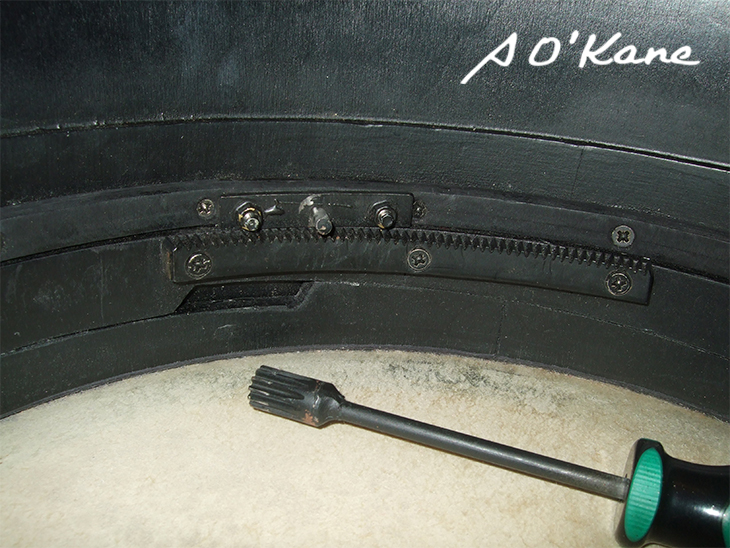
Photo Credit: F. McGuirl
The making was too complicated so I abandoned the system. The mechanism is clever but the over engineering was a bit over the top for bodhráns. It is an important invention more suited to heavy duty industrial applications.
TENSIONING SYSTEM
5. Single Screw – Band Tensioner
Still in pursuit of a single screw system I reverted to what I had made to tension the old Snowcem tin drums when I was young.
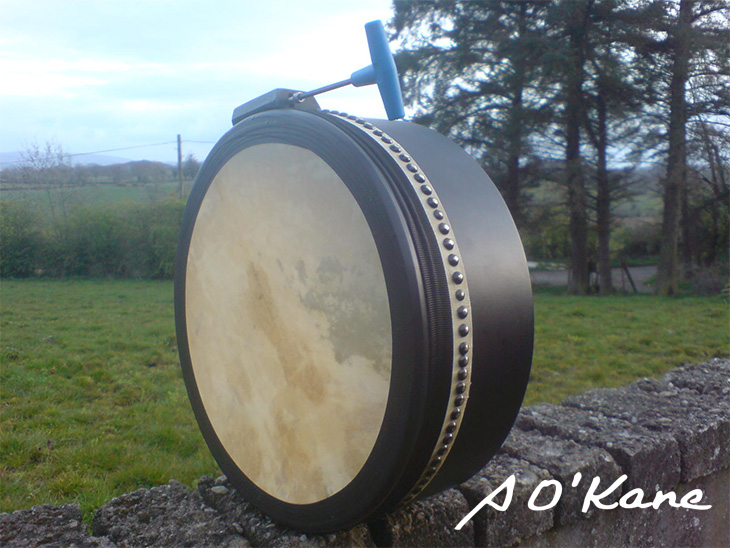
For a variety of reasons of both usability and sound production it is an improvement on all other systems. However it has its limitations in countries where there is a very wide range of humidity variation. For those conditions I now feel happier to supply the 8 screw type.
TENSIONING SYSTEM
6. THE NEW CAM TYPE
Since nobody has developed the old cam system I decided to revamp it for the ladies because of the availability of new materials and fittings.
I have simply increased the tuning range by making the cam bigger and from Black Delrin The delrin edge is roughed up to make an friction surface between the wheel and tone ring edge. This is done to prevent slipback. This again makes the system a finger tuning system.
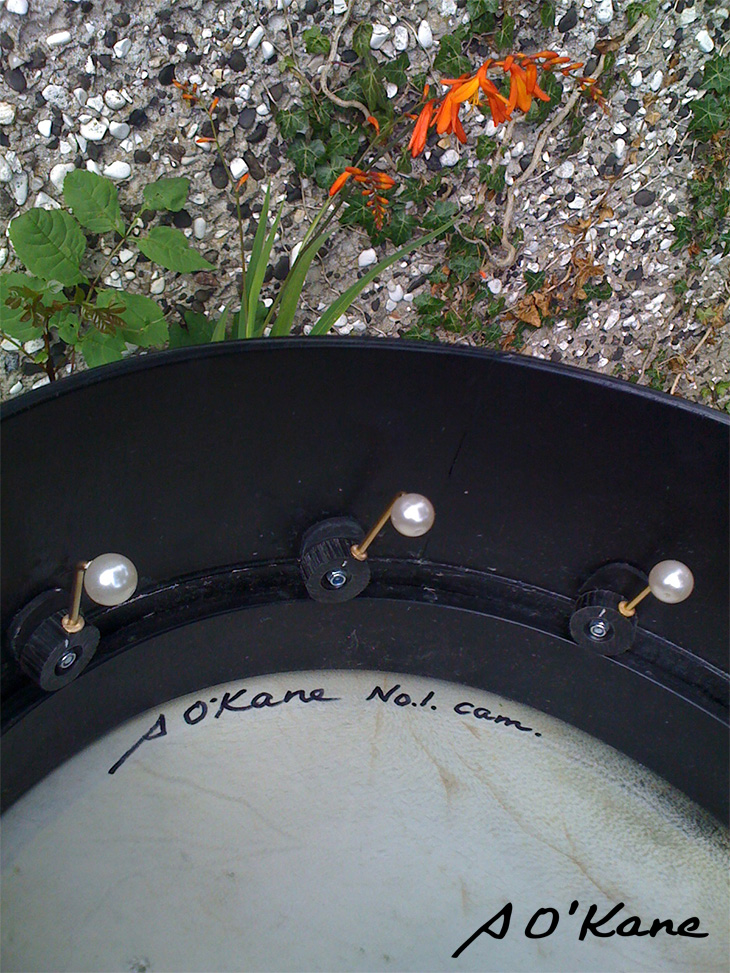
TENSIONING SYSTEM
7. THE 8 KNOB TYPE
Since the fashion in drums has changed I have started to make the 8 screw type into a finger tuning system. In the 80’s I made a metal finger tuning system by brazing 2 intersecting washers into the cross heads of spouting bolt . I still have this drum that I use as a sound reference.
The plastic knobs are tilted away from the shell for ease and comfort of use (see 3rd photograph below) and the operational tensioning length much increased to cover every possible tuning situation.
I suppose to call this a new design would be an exaggeration since it is simply the replacement of a screw for a knob.
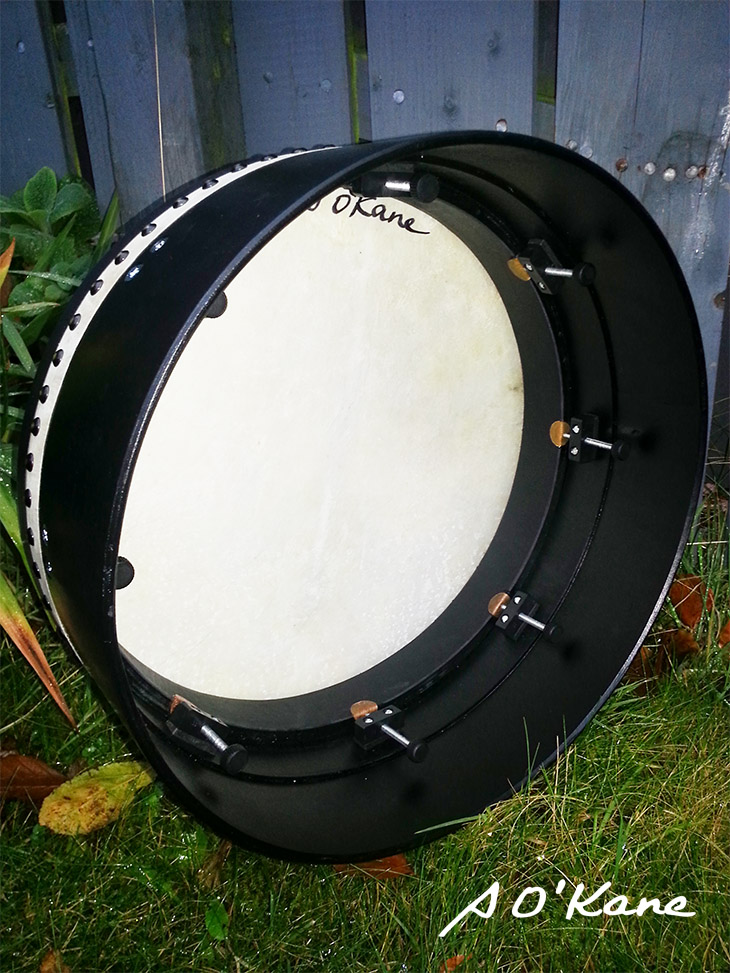
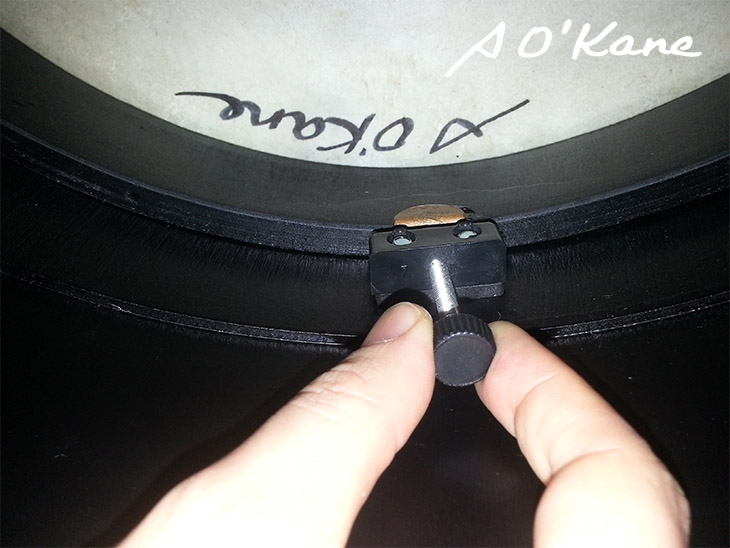
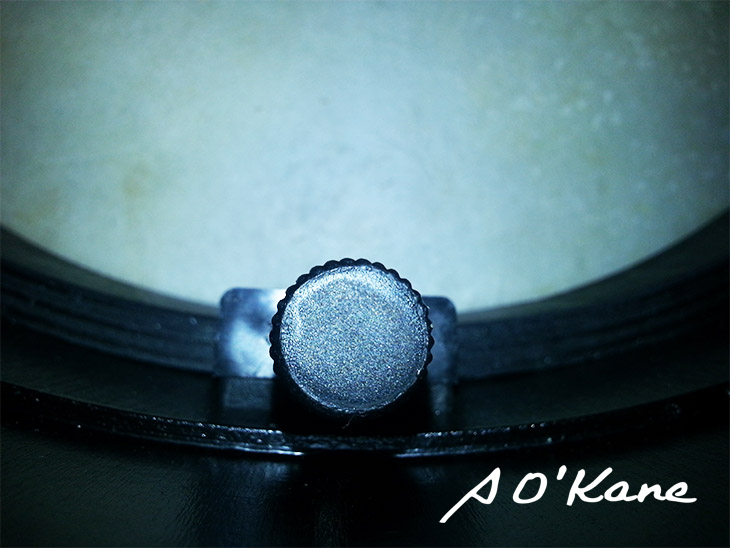
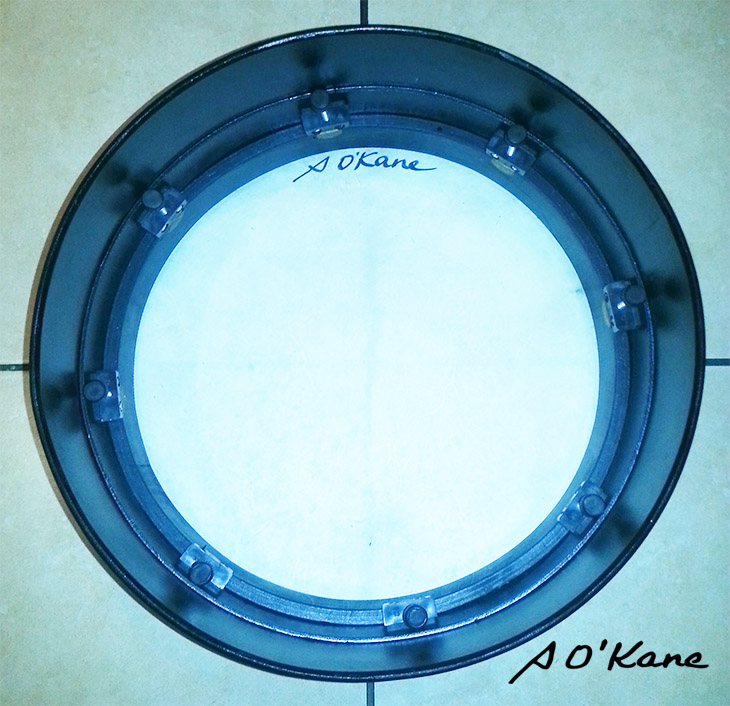
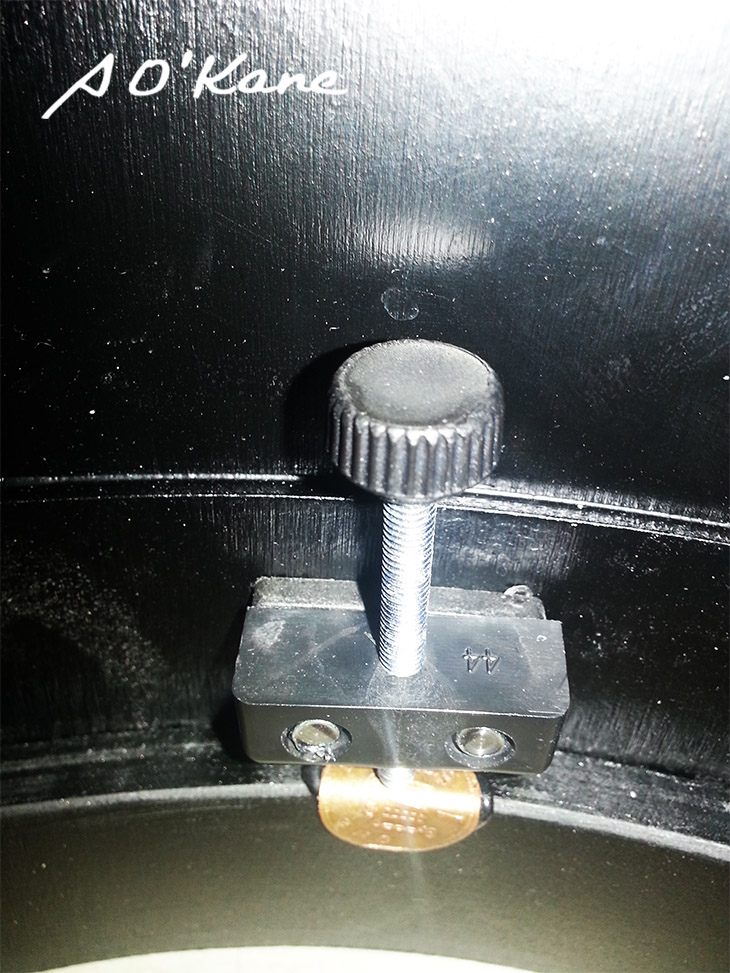
SHELL DEPTH REDUCTION
Increasingly I have noticed that the deeper the shell, the woolier the sound output for players who regularly use amplification. To combat this problem I have been reducing the shell depth by about 1” the effect is that the resonance decreases, the beats more defined and hence the volume can be decreased without loss of drive or increased without distortion.
I am now making all my bodhráns between 4.5"s - 6"s depth, on request.
Design summary:
In reality the design has changed little since the 2 first tensioning systems. Many ideas that seemed ok at the time have fallen by the wayside or are falling by the wayside. Many design lead wildly away from the design progress. As guidance for young designers / makers and players I feel that players make a choice of drum sounds… one being strongly percussive and usually oiled …the other being less sharply percussive and more musical. These types usually have taped edges. Obviously I have voted with my feet as to which path I prefer…but both have equal importance.
The way forward seems inexorably leading to sensitivite playing. The existing problems of over sensitivty to climatic changes has not been answered, particularly for the lambeg style skins with taped edge.
How to soften a hard heavy skin without using chemicals or oils
Added to website: Wednesday, 15th of April, 2020
Further to your softening of the drum issue. This method outlined below is akin to hard playing in.
The method is breaking down some of the fibre bonds. It's what many native cultures do... but in a different way. Some native American tribes pull the skin over a well polished stake in the ground... pointed so that the end is about 1" ball point, that is polished smooth. this is breaking down the fibre bonds.
For the drum ...if it has a bar remove it... to do this hit the inside beside the bar a couple of good cracks with a hammer so that the nails heads are forced away from the shell so that you can pull them out with pliers. Remove the nails on one end, and lever the bar free from the other side. This will give you access to the skin.
- Mark with a pencil and mark from centre to the middle of where the tuning blocks are. This will divide the drum into 8 segments. Then mark a series of circles from the centre to the edge about 1" apart. If you want to make your drum sound like a bigger diameter drum make your centre about 2" off centre... if that make any sense to you.
- Place a bit of carpet onto the bench. so that you can hammer into the skin from the inside with the beaten side of the drum on the carpet. This will give enough stretch to break the fibres.
- Using a Ball Pein Engineers Hammer, starting from as close to the shell as you can get, hammer hard the skin very methodically following the marked circles and each blow about 1/2" apart and the same weight of blow each time.
- When you get in about 4" from the shell, test if the sound is what you want... if not keep going, but you want a hard bit at least 4" diameter in the centre.
When you are happy with the softened sound:
Thats how to do it mechanically. You may prefer this method, as it retains the bright sounds... whereas oils etc give dull sounds. It also allows you to balance hardness with resonance.
Good luck and happy hammering both before and after the softening... euphemistically known as playing in.
Seamus
The Patch
Added to website: Tuesday, 24th of November, 2020
Because of new materials coming onto the market, I now put a percussive patch on all my drums.
Forty-five years ago, I had experimented and used the idea. It was a hard, thick, see-through plastic sheet stuck onto the flesh side of the skin using Photo Stick.
Sound wise, it was successful, but, because of the adhesive and the material used, it failed after a couple of years, and permanently left an unsightly adhesive deposit.
The gel stuff that has been on the market for years is no advantage to bodhrán players for a number of reasons.
Lately, I discovered this new material that has led me back to the old idea. With this new material, it answers all the problems and adds greatly to the design story of the drum. Further to that, it is comfortable to the player, if slightly obtrusive.
Advantages:
Disadvantages:
To summarise, In my opinion it is a significant advance, not anywhere as huge as taping the skin has been but most definitely a big advance. I have made about 40 in the past 2 years and the feedback has been very positive.